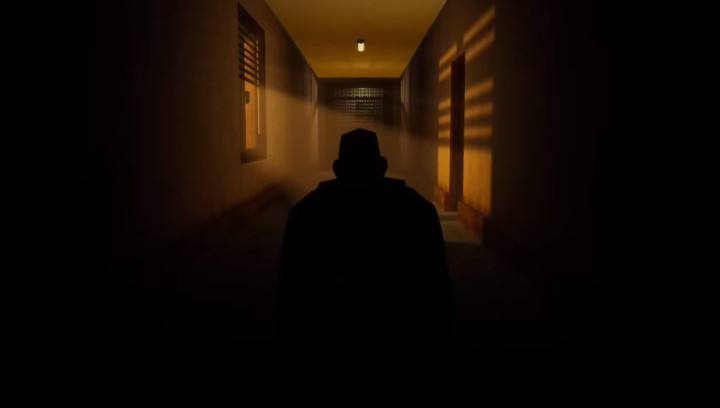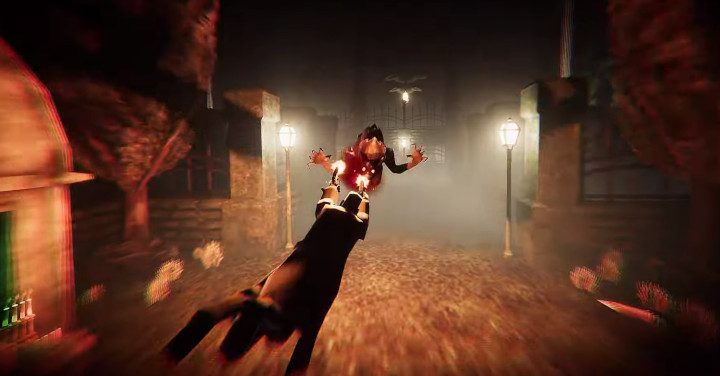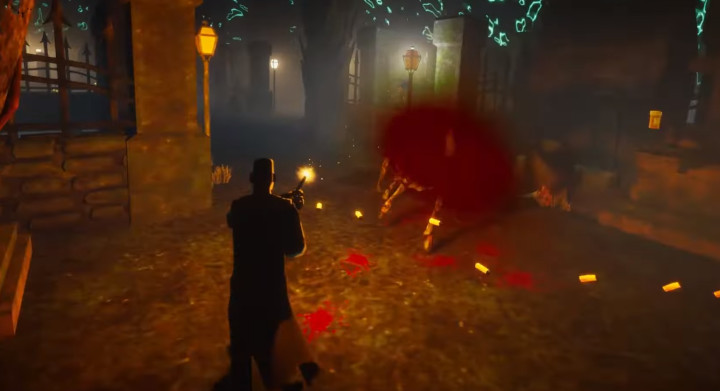
As an ardent fan of Max Payne (and really, I’m a fan of everything Remedy has put out), I was quite interested in checking out what appeared to be developer/publisher Strange Scaffold’s homage to the Polish development studio’s original hardboiled New York detective game. The game I am referring to, of course, is El Paso, Elsewhere.
Although low in polygons and minimalist in cutscene animations, the opening several minutes had me hooked. Grizzled noir voiceover from a down-on-their-luck detective-looking fella? Check. Pulpy dialogue and a penchant for flowery prose and hyperbole? Check. A left-of-field, weird and nebulous plot that is somehow also barebones and right to the point? Check. And finally, balletic slow-mo bullet-time gunplay, replete with dives that — if you hold the button down — will allow the protagonist to remain prone to continue his volley of bullets? Check to infinite.

But the more I played El Paso, Elsewhere, the more the actual structure of the game reminded me of more punishing shooters like Hotline Miami. I often found myself having to think beyond just the standard shooty-shooty bang-bang and delve into strategy and resource-management. Even though there is a sizable arsenal of familiar firearms to take advantage of, if you are not paying attention to just how few bullets you have, you can quickly find yourself in a pickle.
Although I did have some issues with El Paso, Elsewhere, overall I was impressed by this indie shooter. In fact, I can imagine returning to it down the road when I have an itch for a more punishing approach to the Max Payne formula. And that means I don’t have to try to get Max Payne on Steam to run without crashing.
The voice acting in El Paso, Elsewhere might be lacking that certain James McCaffrey magic (coincidently the main character in El Paso is named James), but, despite that, it’s surprisingly solid. Honestly, I did not expect such crisp writing and pitch-perfect delivery. I bought every word and hung on every syllable (even if I never quite bought the fact that the voice I was hearing was meant to be emanating from the character I was playing). Overall, the sound design is really well done, from the ambient background music to the needle-dropped songs; it all feels great and adds a wealth of mood and texture.

I also really enjoy the art style. As barebones and low-poly as it is (which isn’t always my thing), I found it to be rather charming — it’s not at all distracting, nor does it detract from the action onscreen. The lighting effects are also well done, which can be a great addition to lower-res games to help add that visual pop and flourish without bleeding-edge graphics.
To return to my Max Payne comparison, I think Strange Scaffold nails that Remedy je ne sais quoi. And this is no small feat, especially for what I would have to imagine is a rather small independent studio. This team is clearly students of Remedy’s output — for the most part, they pay homage to that Remedy vibe fairly impressively, even on a smaller scale. This was cemented for me when I stumbled upon a radio I that was broadcasting a radio show, which felt right at home amongst shows like Night Springs or Address Unknown.
However, it ain’t all good. I was a little turned off by the controls, and this is where El Paso, Elsewhere stumbles the most for me. Now, I should note that I played this on a Steam Deck, so I wasn’t using a mouse and keyboard. El Paso, Elsewhere does offer full controller support (although during my playtime, the onscreen prompts didn’t actually display which button corresponds to the action being prompted), so it works just fine with no major issues, and I didn’t have to remap any of the bindings.

But the character feels a bit tanky to control, and the camera, which is set a little above the character, can get a little dodgy if you get backed up against a wall or in a corner. This last bit can be especially maddening when you’re trying to aim a third-person reticle. Plus, even though it looks like that reticle is hovering over the enemy, sometimes bullets are just dust in the wind. Thankfully, a melee stake can always dispatch these pesky vamps in a pinch.
There is also some light platforming that, although a little wonky, doesn’t tank the entire experience like playing the friggin’ blood maze in Max Payne using a PS2 controller. I don’t mind a little variety in traversal, but it feels a bit harrowing to navigate the minor gaps you have to jump over. Thankfully, the game doesn’t make a big production of it, and these sections are used sparingly.
Without going too far into spoilers, the basic story here is that your ex-girlfriend — who happens to apparently be a female Dracula — is summoning demons or is trying to open the gates of Hell… or something. And you have until X O’clock to shut it down and save humanity. It’s a bit whacky and not very engrossing, but it provides ample excuse to kill bad guys and listen to grizzled noir monologues, so for that purpose it is fine enough.

So yeah, I like El Paso, Elsewhere, and I would definitely recommend it to folks who can still stomach the original Max Payne in all its low-poly glory. It’s a bit kooky and off-kilter, and it offers solid — and, at times, challenging — third-person stylized action that you really just don’t see much of in the gaming landscape these days. And hot on the heels of a game like Trepang 2, El Paso, Elsewhere helps buoy my hopes that we may finally be on the cusp of a much-needed bullet-time renaissance in video games, which I am very much on board for.
Disclaimer: I was given a review code for El Paso, Elsewhere on Steam, but the opinions expressed in this article are my own.